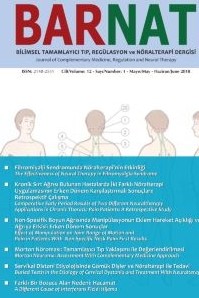FİBROMİYALJİ SENDROMUNDA NÖRALTERAPİ’NİN ETKİNLİĞİ
Fibromiyalji sendromu (FMS), kronik yaygın vücut ağrısı, yorgunluk, sabah tutukluğu, subjektif şişlik, uyku bozukluğu, bağırsak problemleri, multiple somatik ve bilişsel problemlerle karakterizedir. Temel olarak, vejetatif sinir sisteminin (VSS) kronik yüklenmesi ileortaya çıkan lenfatik dolaşım bozukluğu ön plandadır. Bu kapsamda bozucu alanlar da önemli bir yüklenme sebebidir. Lenfatiksistemin etrafını saran VSS’nin regülasyonu ve latent asidozla mücadele ana tedavi yaklaşımı olmalıdır.Bu çalışmada ACR 1990 Tanı Kriterlerine göre FMS tanısı konuşmuş 113 hastanın dosyası retrospektif olarak incelendi. Hastaların büyük çoğunluğunda latent asidoz, hormonal disfonksiyon ve çoklu bozucu alan tespit edildi. Hastalara ortalama 6.1 ± 3.2 Nöralterapiseansı uygulandı. Likert skalasına göre çok iyi ve iyi kategorileri birlikte değerlendirildiğinde tedaviden sonra hastaların % 76.1’ndeNöralterapinin oldukça etkili olduğu görüldü. Tedaviden 17.7 ± 15.4 ay sonra yapılan görüşmede ise bu oranın % 65.5 olarak devam ettiği gözlendi. Hastaların % 15.9’u orta, % 1.8’i hafif ve % 6.2’si etki yok şeklinde değerlendirme yaptı. Bu çalışmadan eldenedilen sonuçlar; Nöralterapinin, tedaviye direnç gösteren nedenlerin ortadan kaldırılmasında etkili bir tedavi yöntemi olabileceğinigöstermiştir
Anahtar Kelimeler:
Fibromiyalji sendromu, Vejetatif sinir sistemi, Nöralterapi, Tamamlayıcı tıp
THE EFFECTIVENESS OF NEURAL THERAPY IN FIBROMYALGIA SYNDROME
Fibromyalgia syndrome (FMS) is characterized by chronic widespread body pain, fatigue, morning stiffness, subjective swelling, sleepdisturbances, bowel problems, multiple somatic and cognitive problems. Basically, the impairment of lymphatic circulation causedby the chronic loading of the vegetative nervous system (VSS) is the forerunner. In this context, interference areas are also a significant burden. Regulation of VSS that surrounds the lymphatic system and fight against latent acidosis should be the main treatmentapproach.In this study, the files of 113 patients who were diagnosed with FMS according to the ACR 1990 Diagnostic Criteria were retrospectively reviewed. In the vast majority of patients, latent acidosis, hormonal dysfunction and multiple destructive areas were detected.A mean of 6.1 ± 3.2 neural therapy sessions was performed. When the good and good categories were assessed together accordingto the Likert scale, it was observed that 76.1% of the patients were highly effective in neural therapy. It was observed that this ratiocontinued to be 65.5% after 17.7 ± 15.4 months of treatment. 15.9% of the patients were moderate, 1.8% were mild and 6.2% hadno effect. The results has shown that neural therapy can be an effective treatment modality for removing treatment-resistant causes.
Keywords:
Fibromyalgia syndrome, vegetative nervous system, neural therapy,
___
- 1
- ISSN: 2148-2551
- Başlangıç: 2006
- Yayıncı: Bilimsel Nöralterapi ve Regülasyon Derneği
Sayıdaki Diğer Makaleler
FİBROMİYALJİ SENDROMUNDA NÖRALTERAPİ’NİN ETKİNLİĞİ
Sibel Çağlar OKUR, Ferda FİRDİN, Sevil KILIÇ ÖZTÜRK, Tijen ACARKAN, Şafi EDEMCİ, Meltem VURAL, Hüseyin NAZLIKUL
SERVİKAL DİSTONİ ETİYOLOJİSİNDE GÖMÜK DİŞLER VE NÖRALTERAPİ İLE TEDAVİ
Mustafa KARAKAN, Osman ÖNCEL, , Tijen SECERLİ DÜRER, , Yusuf TAMAM, Hüseyin NAZLIKUL
MORTON NÖROMASI: TAMAMLAYICI TIP YAKLAŞIMI İLE DEĞERLENDİRİLMESİ
Banu TAMAM, Cüneyt TAMAM, Yusuf TAMAM
